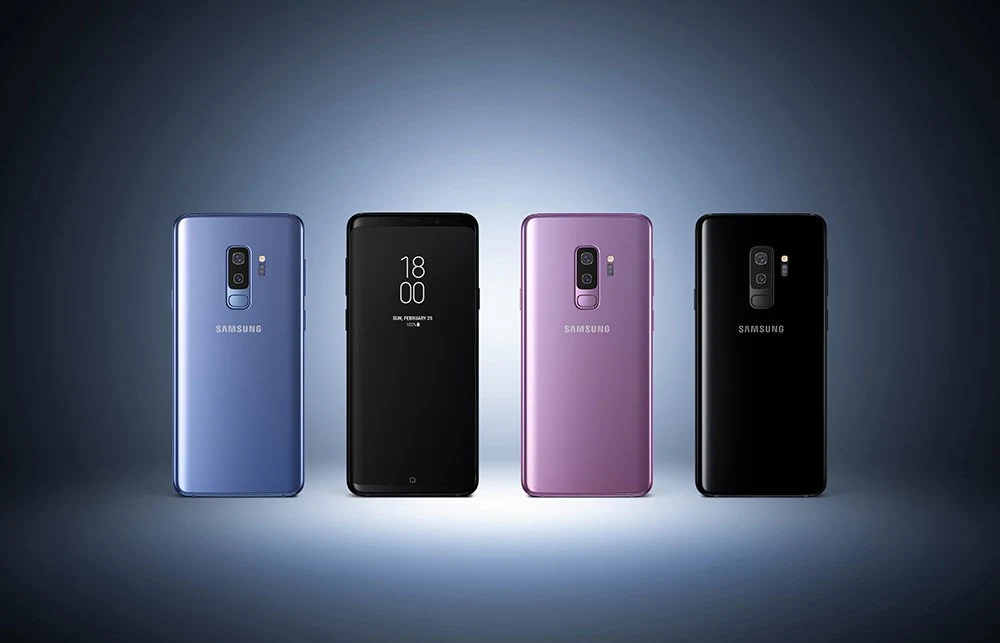Finally, after tons of leaks and hype, Samsung unveiled the Galaxy S9 and Galaxy S9+ with global availability set for March 16. The company’s flagship Galaxy S handsets for 2018 sport minor design changes compared to their predecessor but feature vastly improved camera and specifications.
As expected, the design of the phone didn't change much from last year, let’s quickly cover the big spec differences. The Galaxy S9 features a 5.8″ QHD+ Curved Super AMOLED display, Snapdragon 845 processor, 4GB RAM, storage options starting at 64GB up to 256GB, rear-facing 12-megapixel camera, 3,000mAh battery, wireless charging, fingerprint reader on the backside, AKG-tuned stereo speakers, plus Android “Oreo” at launch.
The Galaxy S9+ is of course similar to the smaller Galaxy S9, but comes with a larger 6.2″ QHD+ Curved Super AMOLED display, 6GB RAM, dual rear-facing cameras with OIS (Wide-angle: Super Speed Dual Pixel 12MP AF sensor (F1.5/F2.4), Telephoto: 12MP AF sensor (F2.4)), and a larger 3,500mAh battery.
To make this phone different, much, Samsung has to incorporate other changes to make these phones stand out from last year’s. To do so, Samsung focused on the camera(s), entertainment experience (stereo speakers), new DeX Pad compatibility, as well as security with Knox 3.1 software
For those who are fans of slow motion shots, the Galaxy S9 and S9+ are capable of 960 frames per second (FPS). Additionally, the devices also offer automatic Motion Detection, a feature that detects movement in the frame and automatically begins to record. After shooting your Super Slow-mo clip, you can select background music from 35 different pre-installed options or add your own personal music.
To compete with Apple’s Animoji, Samsung is also including AR Emoji on these devices. AR Emoji uses a, “Data-based machine learning algorithm, which analyzes a 2D image of the user and maps out more than 100 facial features to create a 3D model that reflects and imitates expressions, like winks and nods, for true personalization.” To the delight of users, these AR Emoji can also be used in a range of 3rd-party messaging platforms.
Here’s how Samsung describes the Low Light Camera and Bixby tech.
Both phones will be available through Samsung.com and the Shop Samsung app. The Unlocked Galaxy S9 is $719.99 or $30/month with 24 months financing, while the unlocked Galaxy S9+ is available for $839.99 or $35/month with 24 months financing.
As expected, the design of the phone didn't change much from last year, let’s quickly cover the big spec differences. The Galaxy S9 features a 5.8″ QHD+ Curved Super AMOLED display, Snapdragon 845 processor, 4GB RAM, storage options starting at 64GB up to 256GB, rear-facing 12-megapixel camera, 3,000mAh battery, wireless charging, fingerprint reader on the backside, AKG-tuned stereo speakers, plus Android “Oreo” at launch.
The Galaxy S9+ is of course similar to the smaller Galaxy S9, but comes with a larger 6.2″ QHD+ Curved Super AMOLED display, 6GB RAM, dual rear-facing cameras with OIS (Wide-angle: Super Speed Dual Pixel 12MP AF sensor (F1.5/F2.4), Telephoto: 12MP AF sensor (F2.4)), and a larger 3,500mAh battery.
To make this phone different, much, Samsung has to incorporate other changes to make these phones stand out from last year’s. To do so, Samsung focused on the camera(s), entertainment experience (stereo speakers), new DeX Pad compatibility, as well as security with Knox 3.1 software
Camera Improvements
Even though Samsung’s Galaxy devices are already known for very good mobile cameras, there is always room for improvement, something Samsung doesn’t seem to have much of an issue doing year-over-year. For the new S9 and S9+, Samsung is including Super Slow-mo, Low Light Camera, AR Emoji, and Bixby AI enhancements.For those who are fans of slow motion shots, the Galaxy S9 and S9+ are capable of 960 frames per second (FPS). Additionally, the devices also offer automatic Motion Detection, a feature that detects movement in the frame and automatically begins to record. After shooting your Super Slow-mo clip, you can select background music from 35 different pre-installed options or add your own personal music.
To compete with Apple’s Animoji, Samsung is also including AR Emoji on these devices. AR Emoji uses a, “Data-based machine learning algorithm, which analyzes a 2D image of the user and maps out more than 100 facial features to create a 3D model that reflects and imitates expressions, like winks and nods, for true personalization.” To the delight of users, these AR Emoji can also be used in a range of 3rd-party messaging platforms.
Here’s how Samsung describes the Low Light Camera and Bixby tech.
- Low Light Camera: Good lighting is the secret to any great photo. But often, photos are taken in less-than-ideal lighting conditions and most smartphone cameras have a fixed aperture that can’t adjust to low or bright lighting environments resulting in grainy or washed out pictures. Similar to the way the iris of a human eye expands and contracts, Samsung’s Dual Aperture2 (F1.5 / F2.4) automatically lets in more light when it’s dark and less light when it’s too bright, taking photos that are crisp and clear.
- Bixby: Samsung’s intelligence platform, integrated into the camera, uses augmented reality and deep learning technologies to provide helpful information about a user’s surroundings3. With real-time object detection and recognition, Bixby instantly generates information directly on top of the image that the camera is pointing at. Users can translate foreign languages and currency in real time with Live Translation, learn about their surroundings, purchase products seen in the real world and track calories throughout the day.
Pricing and Availability
The Galaxy S9 and S9+ will be available in the U.S. starting March 16, 2018. Pre-orders begin March 2, 2018. Staring March 2, if you pre-order a Samsung Galaxy S9 or Galaxy S9+, you can save up to $350 with a qualifying trade-in.






0 Comments